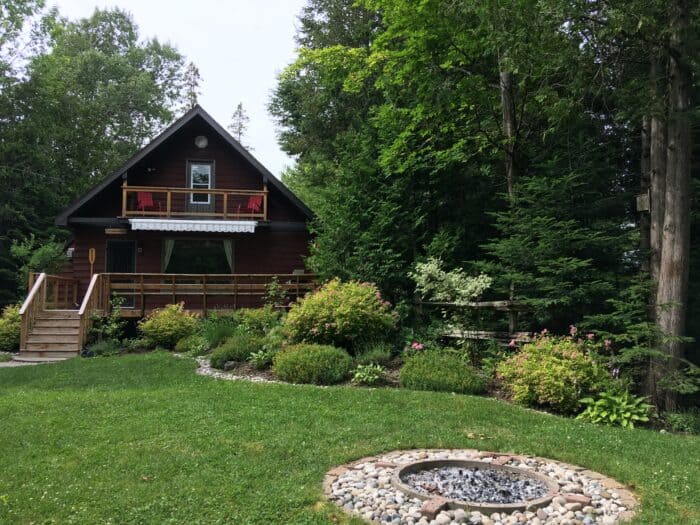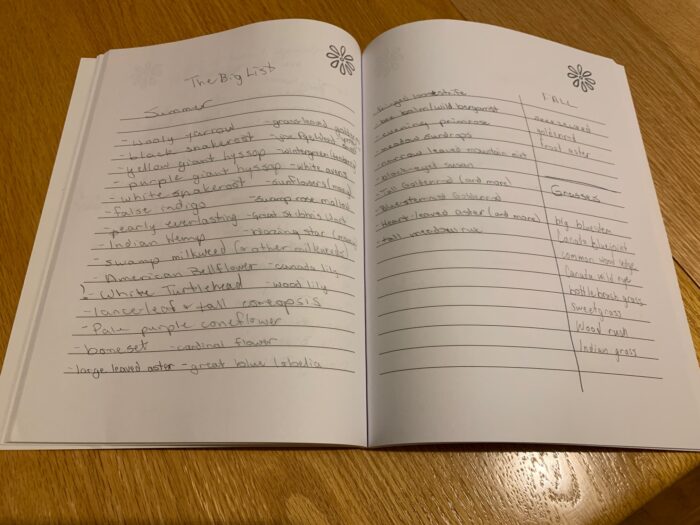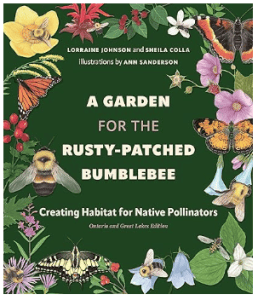Hey there, fellow nature enthusiast! Let’s chat about something truly special: native gardens. Yes, I know what you’re thinking … “Hey Carol, you’ve already posted stuff about gardening with native plants!” Of course you’re right – and yet I don’t think I’ve thoroughly discussed why using native plants in your garden is a big deal. Planting native gardens isn’t just about saving monarch butterflies and the planet at large, it’s about being completely yet covertly self-indulgent!
In the spirit of full disclosure, here’s a picture of my cottage garden – none of the selections are classed as invasive (that I know of) but a good 80-85% of the plants in there were not native and some of them required regular effort to contain. While not necessarily invasive, many of these selections don’t contribute much to the local ecosystem.

In the home just before we moved to the woods the gardens were much worse! There we inherited invasive ivy, vinca and lilies along with an assortment of other annoying weeds. We didn’t do anything to remove them but I did occasionally attack them to at least keep them contained. I simply didn’t have the bandwidth at the time to take decisive action.
And that’s WITH a formal education in landscape design and maintenance!
I truly didn’t know that I should care so much about what I’m putting in the garden. I was taught that aesthetic was the most important value of a landscape design. It wasn’t until I started to think about landscaping our home in the woods and thinking even more about reducing our impact on the land, that the notion of using native plants started to brew in my mind.
I started researching more, and following conversations on the typical social media platforms about more sustainable landscaping practices. The more research I do the more important the use of native plants becomes to me. So, kick back, grab a cup (or glass) of your favorite beverage, and let’s delve into what I’ve learned so far about why it’s incredibly important and wildly selfish to embrace landscaping with locally native plant selections.

It Feels Good to Garden with Native Plants
Beyond the real health benefits of getting outside and getting the movement that gardening provides, it feels good to create beautiful things and to help others. With our native gardens we’re helping all beings and the earth itself on ecological, physical and emotional levels. It feels good to know that my efforts in researching the plants, and taking the time to make good choices are creating positive ripples here in the woods and beyond. It makes me feel more connected to the land and humanity.
Gardening with native plants here in the woods has become a significant part of the grander theme of slowing down and noticing simple pleasures. It makes me stop and notice the plants that naturally occur here and around the neighbourhood – even though that might agitate Brian a wee bit as I zig-zag around the neighbourhood like a puppy on our walks, snapping pictures of plants to research later.

This “feel good factor” reminds me of the book 29 Gifts by Cami Walker. “29 Gifts is the insightful story of the author’s life change as she embraces and reflects on the naturally reciprocal process of giving. Many of Walker’s gifts were simple-a phone call, spare change, a Kleenex. Yet the acts were transformative. By Day 29, not only had Walker’s health and happiness improved, but she had also created a worldwide giving movement.” But I digress, let’s get back to the plants!
Native Plants = Less Stress & Frustration
Native plants are like the streetwise kids of the gardening world; they’ve weathered storms, droughts, pestilence, rough humans and everything in between, so you can bet they can withstand almost anything you and your garden can throw at them.
These hardy beauties are less susceptible to pests and diseases, meaning you can spend less time in battle with your garden and more time enjoying the fruits (or flowers) of your labour. In fact, many native plants can come back even stronger and more resilient after a good wallop from a garden pest. Yes, I’m talking to you New Jersey Tea and Spice Bush – you who can bounce back better than before after a hungry bunny attack. At least that’s what the books and expert gardeners say – I’ll let you know if it’s true!

Wait a minute! In addition to not having to get stressed or frustrated with your garden is one thing but not having to spend money on pesticides and special fertilizers because the plants are so resilient … another selfish win!
Native Plants (generally) Need Less Water
This one is really interesting because it’s a double win: reduction in water use and savings in your pocket. Here’s how …
Native gardens are eco-superheroes when it comes to water conservation. These plants have adapted to the local climate over centuries, meaning they’re perfectly suited to your area’s rainfall and watercourse patterns. I’m assuming here that you’re planting the right plant in the right place. Please tell me you’re not thinking of planting a swamp loving willow in a dry prairie garden and assuming it will thrive because it’s a native variety. We still need to be mindful of the plant’s core needs when planning our landscapes. That said … let’s carry on with water conservation …

You know how you have to baby non-native plants with extra water until they’re established in your garden? Well native plants establish themselves in a much shorter time. So, in addition to them needing less water in the long term, this helps you reduce water consumption right from the start. Less water usage even at one home means less strain on our already precious water supplies—a win-win for both you and the planet!
Plus using less water saves you money on your water bill. Saving money, when on a rural lot, means saving electricity costs for the water pump. Either way, that’s more money in your pocket! Being selfish and planting native plants for the win again!
Native Plants are Uncommon Beauties
Let’s not forget about the sheer beauty and uniqueness of native gardens. Picture this: a riot of colorful blooms dancing in the breeze, attracting pollinators with their sweet nectar-filled flowers. From the cheerful yellow of Black-eyed Susans to the vibrant red of Cardinal Flowers and natural blues of Blue False Indigo, native plants offer a kaleidoscope of hues that’ll make your garden the envy of the neighborhood.

I can’t believe I’m saying this … the curiosity generated by passers-by as they marvel at the intriguing shapes and textures of native plants also gives us a chance to spread the word – and use – of native plants in others’ landscapes. Why can’t I believe I’m saying that? Because extensive use of exotic plants in the typical home landscape is so expected and mainstream that the use of native plants is now a novelty. How is that even possible? I’m asking that of myself as well – when I was designing and maintaining landscapes professionally I paid little attention to the pedigree of any of my plant selections.
Selfishly:
- You get bragging rights for your lovely garden and
- erm, don’t tell the landscape trades but … ummm … since there’s no funny sciency witchcraft going on with native plants, true native plants are generally less expensive than exotics or man-made cultivars. It’s true that native plants are harder to find at many nurseries but the more we ask for them, the more they’ll have to supply them. In the meantime, seeds are even cheaper and there are a number of ways to grow from seed. We’re saving money all over the place by using native plants!
Using Native Plants Helps Us Repair the Planet
Cheeky or not, no article about the benefits of using native plants would be complete without looking at the bigger picture. Granted, one of us planting a Dogwood isn’t going to save the planet but if we all plant even one native plant in our gardens, that will change the future of the planet. On a grander scale here’s what you need to know:
Protecting Biodiversity
Native gardens are a lot like human communities, bustling with life and interactions! By planting species that naturally occur in your area, you’re providing vital food and habitat for pollinators and local wildlife: from buzzing bees and colorful butterflies to chirping birds and others. These plants have evolved alongside native insects and animals, forming essential relationships that support the entire ecosystem. So, by cultivating a native garden, you’re essentially rolling out the green carpet for your local critters, giving them a cozy place to call home.

The Role of Native Plants in Combating Climate Change
Perhaps the most compelling reason to plant native gardens is their role in combating climate change. As temperatures rise and weather patterns become increasingly unpredictable, native plants play a crucial role in sequestering carbon and mitigating the effects of global warming. By creating green spaces filled with locally native plants, you’re not only creating a sanctuary for local wildlife but also doing your part to protect the planet for future generations.
I wish I had a picture of our full, mature, lovely native plant landscape but we’ve only just started it. Instead, here’s a picture of a meadow planting at the Grey-Sauble Conservation Authority Arboretum & Administration Centre.

Not All Introduced Plants are Villains
Before I leave you to consider introducing more native plants to your home landscape, you should know that not all introduced plants are terrible. Many were brought from the many homelands of forefathers for their medicinal properties or simply for the comfort of feeling a little bit of home in a strange and wild land. With no internet to learn that local alternatives would be available, I can empathize with our ancestors for bringing their pieces of home and culture with them.
Unfortunately, again due to a lack of understanding of how ecosystems work and alternatives available, some of these introduced plants got away from us in a myriad of ways and are now on the invasive list. Some of them have naturalized and pose no significant threat to the local ecosystem – for now at least. I know a lot of the plants have done significant damage. I know that we’re left to deal with the errors of our ancestors, just like future generations will have to deal with ours.
How can you reduce the risk of non-native plants taking over your ecosystem?
While we wait to see if compassionate eradication works, if you are considering purchasing, growing or keeping non-native or at-risk species in your landscape for medicinal, sentimental or aesthetic value, please actively reduce the risk of spread. You can do this by:
- Plant in impermeable containers thus restricting size and root expansion.
- Keep the plants in check by cutting back or pruning them regularly.
- Don’t let the plants go to seed. If the plants do go to seed, capture the seeds before birds and other animals get a chance to carry them away.
- Restrict the spread via roots or rhizomes – usually by actively cutting or pulling plants that begin to spread beyond your intended placement.
- Keep an eye out for pop-ups throughout your space or your neighbour’s and pull them immediately.
How do you start planting native plants in your landscape?
I’m working on a few posts to help you transition your gardens into ecological oases but in the meantime here are three easy ways to begin:
- Look for native alternatives to your non-native favorites. It’s easier than you think! Grow Me Instead is a fantastic resource for finding easy alternatives that you can try right away.
- Take it one plant at a time. You don’t need to rip up your entire landscape and start fresh. Look for existing plants that require the most maintenance or those that seem less healthy and replace those first.
- Get to know your native plants! If you’re in Ontario I highly recommend these two books to start.
Not only are these books absolutely beautiful, the information provided is remarkable!
Planting native gardens isn’t just a hobby, it’s a mission. It’s about nurturing biodiversity, conserving water, fostering resilience, and yes, creating a little slice of paradise right at home. So why not roll up your sleeves, grab your gardening gloves, and join the native gardening revolution? Your garden—and the planet—will thank you for it!
How will you begin your Native Gardening journey?
Recent Posts
Exploring the differences, benefits and drawbacks of Broadcast Sowing and Frost Seeding for Native plants.
Winter sowing is a seed starting method where you sow your seeds in a sheltered container, and set them outside for the winter, here I'll show you how it's done.


